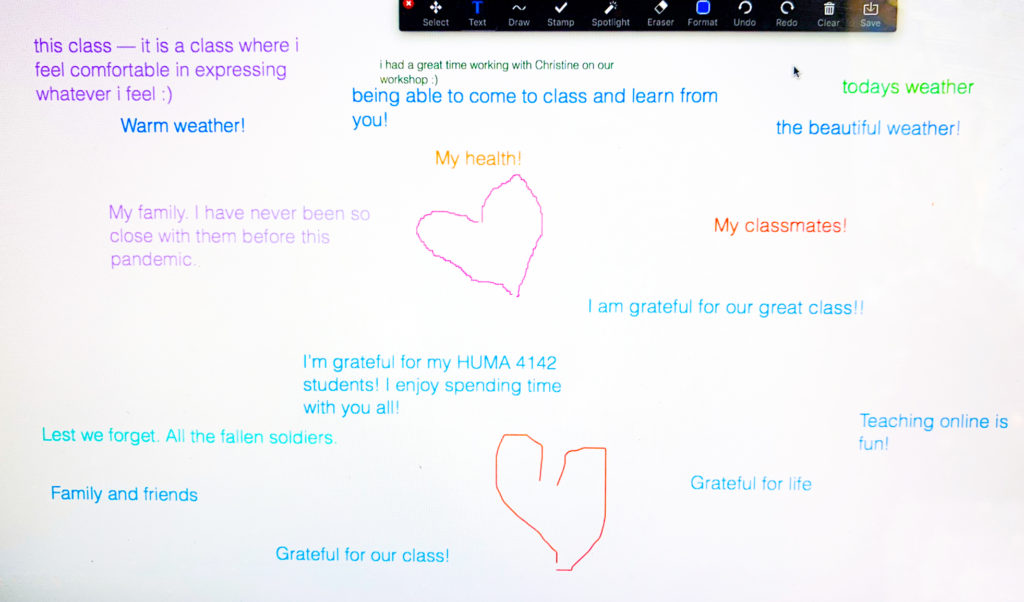
From YouTube-hosted lectures to gamifying the classroom, The Learning Curve is a series showcasing how course instructors in the Faculty of Liberal Arts & Professional Studies are embracing the online learning environment with creative approaches to teaching remotely.
Kate Reid, a Postdoctoral Researcher in the Department of Humanities’ Children, Childhood and Youth program, explains how she’s helping students thrive in an online learning environment with interactive lectures and a focus on mental health.
How are you embracing remote teaching?
When I was planning my Contemporary Children’s Culture course over the summer, I was excited to learn about the Experiential Learning Fund. I took advantage of this opportunity and received funding to provide honorariums for several guest speakers to join my class throughout the year.
Since I designed this course to focus on children’s musical cultures, I wanted my students to hear from children about their own musical engagements. It is critical that they are introduced to a vast array of cultural voices. This semester I engaged the help from a family of three young sisters who draw on their Latinx-Anglo heritage when singing Mexican and English songs. We were also joined by two other girls, one of Japanese and Jewish heritage who played the violin and discussed music that she enjoys. In addition, the class heard from a young Toronto girl sang some songs from her favourite television series.
I also have booked three other adult guest speakers who will join us to talk about their own research relating to children, youth, and music. All of these guest speaker appearances are not only entertaining for my students and me, but also work to enrich assignments and readings, and add a personal and interactive element to the course.
How has the online learning environment changed your teaching style?
One of the things I noticed right away about online teaching was that there is little to no opportunity for students to socialize with each other or me. In normal circumstances when students attend classes in person, they would have the chance to socialize with their classmates as they are walking to and from class, during breaks, and even during class time. The online learning environment, however, is entirely controlled by the instructor. So, building social time into every class with one another and with me has helped to create a welcoming learning environment for my class.
One of the ways I do this is that at the beginning of each class meeting after I welcome students and go over the agenda for that day, I write a few questions in the chat and then put the students into Zoom breakout rooms to let them discuss their answers to the questions. These questions have nothing to do with course content, rather, they are questions that encourage social time and relationship-building. When we re-group, students are invited to share what they discussed in order to give them a little time to share with the whole class and have a chance to speak if they wish. I also share my answers to the questions I pose to the students so that they get to know a little bit about me as well.
I also try to provide different ways for students to participate in class so that those who feel less comfortable speaking during the large group discussion have options in terms of how they engage in class. For instance, I sometimes use a digital communal whiteboard during my class meetings. At the end of a class, I might pose the following statement to students: “Write down one thing you learned from this weeks’ assigned readings,” or “Write down one thing you are taking away from the class today.” Then, they jot down their answers on the whiteboard. I also write down my own answer on the whiteboard with them. This is a fun tool that my students enjoy because it gives them a chance to share their knowledge in a different way rather than speaking it, and it allows them to be a little creative with their responses by using different colours and fonts. It also lets us read all of the different ideas that everyone is gleaning from the readings, and it gives me a sense of some of the big ideas that students are learning from the course.

What has been the biggest challenge of remote teaching?
I have figured out some easy, creative ways to prevent “Zoom fatigue” and disengagement, which I think are challenges in the online teaching world. For example, I sometimes invite students to bring their pets to class and introduce them to everyone. I also sometimes invite students to bring a “study buddy” — stuffed animals, personal mementos, trinkets, a photograph of a loved one, a lit candle — to class to keep them company while learning. Students are always welcome to introduce their study buddy and share why they brought them to class. As well, for our final class meeting in December, we are going to spend the second half of the class having a Winter Break Party where we will be bringing our own snacks, wearing our pajamas, and playing a couple of games and some socializing activities. The students helped brainstorm ideas for this party.
What’s something new you’ve learned from your experiences teaching remotely?
While teaching online, I’ve learned that students really appreciate having conversations about mental health. Many students are struggling with their well-being and workloads—at school, at home, and at their workplaces. Sharing our self-care strategies, doing a check-in with students at the beginning of class, and having conversations about mental wellness is a part of every class. I also occasionally play an optional 5-minute mindfulness meditation from YouTube for students and I do together. If students choose not to participate, they can use the 5-minute break however they like. My students express regularly how much they appreciate these mental health components of our class meetings.
